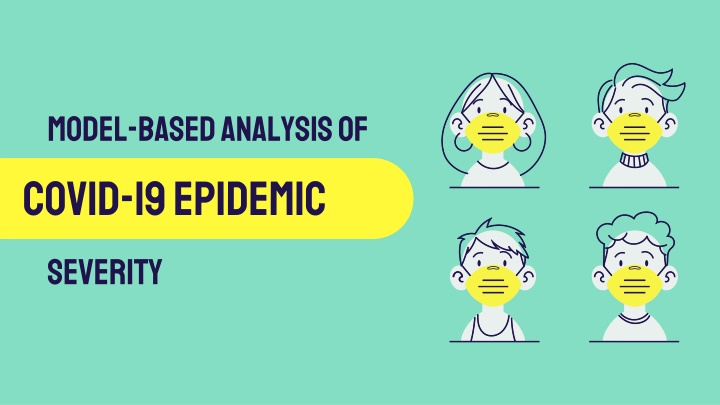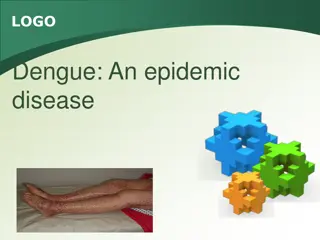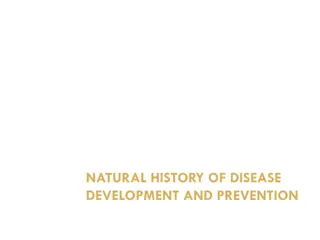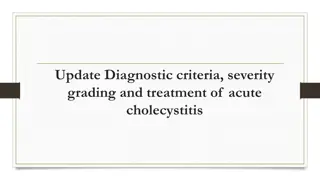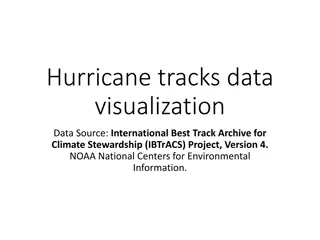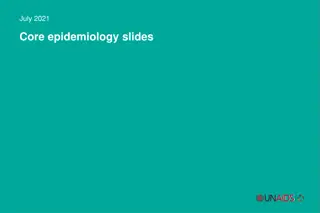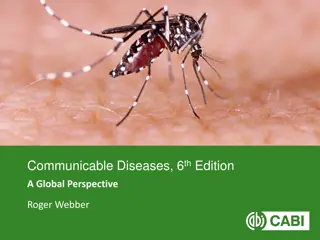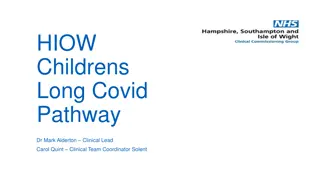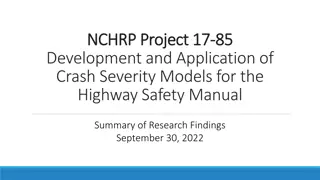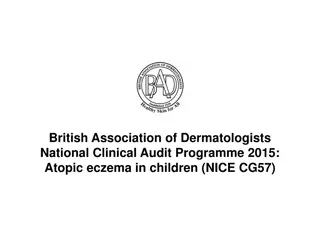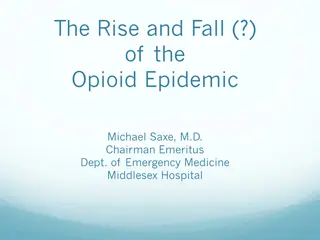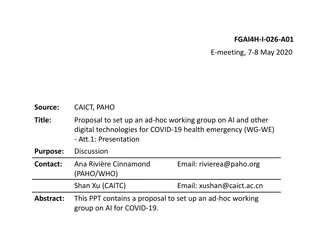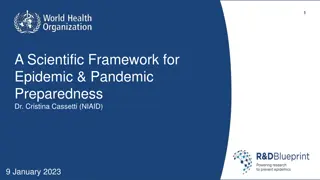Insights into COVID-19 Epidemic Severity Analysis
Clinical studies and model-based analysis provide evidence and categorization of COVID-19 severity, symptoms, and risk factors. Severity stratification shows the distribution among tested patients, highlighting the attack rate and vulnerable populations. Studies aim to estimate severity accurately for mitigation strategies and healthcare planning, emphasizing the need to consider influencing factors.
Download Presentation

Please find below an Image/Link to download the presentation.
The content on the website is provided AS IS for your information and personal use only. It may not be sold, licensed, or shared on other websites without obtaining consent from the author.If you encounter any issues during the download, it is possible that the publisher has removed the file from their server.
You are allowed to download the files provided on this website for personal or commercial use, subject to the condition that they are used lawfully. All files are the property of their respective owners.
The content on the website is provided AS IS for your information and personal use only. It may not be sold, licensed, or shared on other websites without obtaining consent from the author.
E N D
Presentation Transcript
model-based analysis of COVID-19 epidemic severity
Clinical studies have brought some evidence concerning coronavirus disease. The following study will articulate on the basis of this one.
Covid-19 symptoms fatigue fever sore throat cough myalgia pneumonia
COVID-19 severity categorisation respiratory failure, septic shock, other organ dysfunction or failure critical tachypnea, oxygen saturation <93% at rest, PaO2/FiO2 ratio <300 mm Hg) severe influenza-like symptoms mild no showing of symptoms asymptomatic
Severity stratification among tested patients 80% 80% mild-to-moderate cases 14% 14% severe cases 6% 6% critical cases
Attack rate percentage of the virus capacity to infect people 80% No difference in susceptibility across age
People most at risk people with other diseases (diabetes, chronic respiratory and cardiovascular diseases, cancer) older people
Lots of studies have tried to estimate covid-19 severity in order to: Determine the appropriateness of the mitigation strategies Determine the appropriateness of the mitigation strategies Plan for health Plan for health- -care needs care needs
Lots of studies have tried to estimate covid-19 severity IGNORING Misleading factors Deceiving lags of time between the stages of the illness could lead to Deceiving lags of time between the stages of the illness could lead to underestimate the severity of the same underestimate the severity of the same
Lots of studies have tried to estimate covid-19 severity IGNORING Misleading factors Impossibility to foresee the long term outcome of the patients during a Impossibility to foresee the long term outcome of the patients during a growing epidemic growing epidemic
Lots of studies have tried to estimate covid-19 severity IGNORING Misleading factors Biases in reporting cases, low diagnostic capacity: most of the milder Biases in reporting cases, low diagnostic capacity: most of the milder cases won t be noticed cases won t be noticed
Lots of studies have tried to estimate covid-19 severity IGNORING Misleading factors Difference in surveillance system Difference in surveillance system In hospital most of the cases are more severe In hospital most of the cases are more severe In contact tracing and travel history surveillance the cases are In contact tracing and travel history surveillance the cases are milder milder Difference in surveillance system in different country in different Difference in surveillance system in different country in different stages of the epidemic stages of the epidemic
This study aim is to produce robust estimates avoiding biases
Parametric model The reported data aren t enough by themselves to carry a reliable and consistent study. They need t be adjusted for censoring, demography and under-ascertainment. The study follows precise statistic method
Bayesian methods The little data itself isn t sufficient to carry out satisfying estimates, since its availability isn t unlimited. Inserting the owned data in an R software some casual but statistically reliable one could be generated. The study follows precise statistic method
MCMC (markov chain monte carlo) The well-known statistic method allows to treat the individual cases as numerical data and the aggregate ones as probability distribution. The study follows precise statistic method
Available data 24 individual cases from Hubei, China 24 individual cases from Hubei, China data about sex, age, date of symptom onset, date of hospitalisation, and date of death.
Available data 1334 individual cases from outside of mainland China 1334 individual cases from outside of mainland China country or administrative region in which the case was detected, whether the infection was acquired in China or abroad, date of travel, date of symptom onset, date of hospitalisation, date of confirmation, date of recovery, and date of death.
Available data 70117 aggregate cases from China, 1203 deaths 70117 aggregate cases from China, 1203 deaths Data reported until February 11, disaggregated in 10-year age bands. Was also reported the severity of 3665 cases of those.
Available data Passengers from 6 flights from Wuhan Passengers from 6 flights from Wuhan Data from January 30-31 and February 1 flights departed from Wuhan to go back to their home countries.
Available data Passengers from Diamond Princess cruise ship Passengers from Diamond Princess cruise ship Data from the 657 tested positive out of 3711 total passengers and from the 10 deaths.
Onset of symptoms to outcome time Accounting for epidemic growth by using a grow rate of 0.14 per day Using Bayesian method to impute missing onset dates from longer period of time Mean estimation Mean estimation derived from the 24 individual cases 24 individual cases occurred in Hubei: Hubei: 18.8 days 18.8 days
Onset of symptoms to outcome time Accounting for epidemic growth by using a grow rate of 0.14 per day Using Bayesian method to impute missing onset dates from longer period of time Mean estimation Mean estimation derived from the China aggregate cases: China aggregate cases: 17.8 days 17.8 days
Onset of symptoms to outcome time Accounting for epidemic growth by using a grow rate of 0.14 per day Using Bayesian method to impute missing onset dates from longer period of time Mean estimation Mean estimation derived from the 165 individual cases 165 individual cases occurred outside of mainland China: outside of mainland China: 24.7 days 24.7 days
Onset of symptoms to outcome time Combining the previous estimates and adjusting them for every possible bias has lead to this final estimation The red line shows the best fit gamma distribution The blue line shows the best fit corrected for epidemic growth.
Case fatality ratio Combining a uniform attack rate with age-distribution of the population it s possible to obtain the cumulative numbers of cases Obtaining cumulative number of deaths (thus case fatality ratio by dividing it by the number of cases) from the age stratified severity rates Mean estimation Mean estimation derived from the aggregate cases aggregate cases occurred outside of mainland China outside of mainland China 2.7% 2.7%
Case fatality ratio Combining a uniform attack rate with age-distribution of the population it s possible to obtain the cumulative numbers of cases Obtaining cumulative number of deaths (thus case fatality ratio by dividing it by the number of cases) from the age stratified severity rates Different cases brought different estimates Type of surveillance case fatality ratio Age case fatality ratio 1.4% <60 1.1% Hospital surveillance 4.5% >60 3.6% Travel history and contact tracing surveillance
infection fatality ratio Combining the case fatality ratio with a correct infection rate it s possible to obtain a consistent estimate The age stratification of severity allows to calculate the hospitalisation rate, as hospital care is needed in severe or critical cases The infection rate infection rate was deduced from the 6 flights passengers cases demographically neutral 6 flights passengers cases as they were 0.66% 0.66%
infection fatality ratio Infection fatality ratio Boxes represent median Individual represent estimates outside of the range
Each Estimate was then compared with the diamond princess passengers cases The Diamond Princess cruise ship is demographically neutral: every age band and individual type is represented. It s a perfect biome to check if the statistic calculation are consistent with the reality. The empirical reports differ a bit from the estimates but they are part of the credibility interval of error set to the statistical valuation.
Final results The resulting estimates have shown a consistent penchant for age dependant rate: the severity of the disease is strictly related to that factor, along with the presence of other comorbation. Also the health-care system of the country can influence the estimates, although it was shown that also the most advanced ones were easily overwhelmed by the COVID-19 cases.
Final results The estimates previously deduced were based on statistically correct data but machine-produced. Exhausting cases reports will be available just at epidemic unfold, when serological tests will detect the real COVID-19 infection rate.
